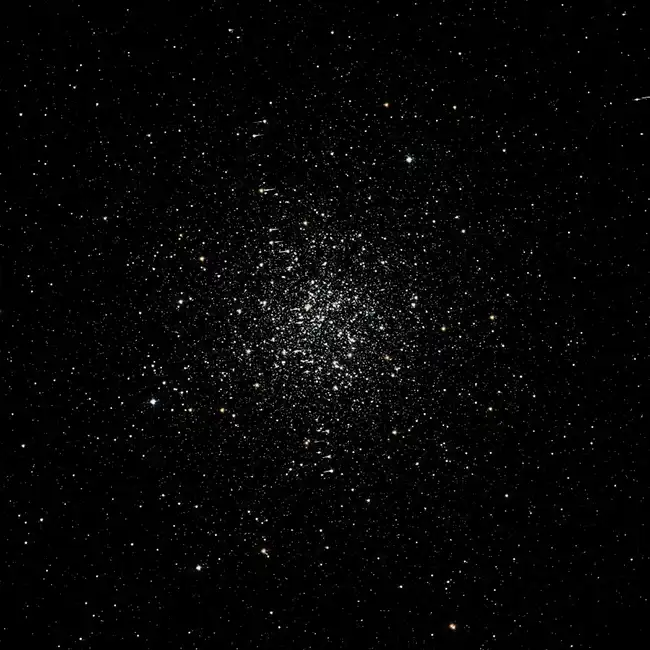Messier 69 (M69), also known as NGC 6637, is a globular cluster located in the constellation Sagittarius. Discovered by Charles Messier in 1780, this dense cluster of stars is part of the Milky Way galaxy and is notable for its compact and bright appearance. While not as famous as some other Messier objects, M69 offers a fascinating glimpse into the ancient star populations of our galaxy.
Description and Magnitude
M69 is a globular cluster, meaning it is a spherical collection of stars bound together by gravity. These clusters typically contain hundreds of thousands to millions of stars, many of which are among the oldest in the universe. M69 is relatively compact, with a diameter of about 85 light-years, and it is located approximately 29,700 light-years from Earth.
The cluster has an apparent magnitude of 7.6, which makes it visible in small to medium-sized telescopes, though it is too faint to be observed with the naked eye. M69 is a dense cluster, with a concentration of stars that becomes more apparent as you observe it through a telescope.

Season to Observe Messier 69
M69 is best observed during the summer months, particularly from June to September. It is located in the constellation Sagittarius, which lies in a rich region of the Milky Way. Sagittarius is prominent in the southern sky for observers in the Northern Hemisphere and reaches its highest point in the sky around midnight during summer.
This cluster is more easily visible from southern latitudes, where Sagittarius rises higher in the sky. However, it is still observable from most locations in the Northern Hemisphere, particularly in the southern United States and parts of Europe.
Constellation and Location
M69 resides in the constellation Sagittarius, which is also home to the famous Teapot asterism. Sagittarius is one of the most recognizable constellations in the sky and is known for its many deep-sky objects, including the bright globular clusters M22 and M28, as well as the center of our galaxy.
To locate M69, start by identifying the Teapot asterism in Sagittarius. The Teapot's handle points toward the south, and M69 can be found just to the east of the handle, near the stars Kaus Australis and Ascella. It lies roughly 2 degrees northeast of Ascella (Zeta Sagittarii) and just under 2 degrees southwest of another globular cluster, Messier 70 (M70). M69 is relatively close to the galactic core, so the surrounding region is rich in stars and other deep-sky objects.
How to Find Messier 69
M69 can be found using a small to medium-sized telescope. Here’s a step-by-step guide to locating the cluster:
- Find Sagittarius: First, identify the Sagittarius constellation in the southern sky. The Teapot asterism is an excellent guide.
- Locate Ascella (Zeta Sagittarii): Ascella is one of the stars that form the Teapot's handle. It shines at magnitude 2.6 and is relatively easy to spot.
- Find M69: From Ascella, move your telescope slightly northeast (around 2 degrees) to find the faint glow of M69. A low-magnification eyepiece will help you locate it initially, and you can switch to a higher magnification for a closer look at the cluster's dense core.
While M69 is not as bright as other globular clusters, its compact nature makes it a rewarding object to observe, particularly in dark-sky locations.

History
Messier 69 was discovered by the French astronomer Charles Messier on August 31, 1780, during his search for comets. He added it to his famous catalog of nebulae and star clusters, which now bears his name. Messier's catalog was created to help astronomers distinguish between comet-like objects and actual comets, which was the focus of his work. Messier described M69 as a "nebula without stars," a common description in an era before more powerful telescopes could resolve the individual stars within globular clusters.
The same year, Messier also discovered Messier 70, a nearby globular cluster with similar characteristics. These two clusters are often mentioned together in observations, as they are only a few degrees apart in the sky.
M69 was later studied in more detail by 19th-century astronomers using larger telescopes, which revealed its true nature as a dense globular cluster of stars. Modern observations have provided more precise measurements of its distance, size, and star population, adding to our understanding of these ancient star clusters.
Conclusion
Messier 69 may not be the most famous globular cluster, but it offers a unique glimpse into the dense and ancient star populations of the Milky Way. Located in the rich constellation of Sagittarius, it is a rewarding target for amateur astronomers, particularly during the summer months. Whether you're scanning the skies with a small telescope or simply enjoying the beauty of the Milky Way, M69 is a reminder of the wonders that lie within our galaxy.
